|
|
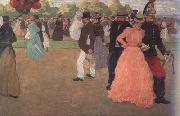 |
Henri Evenepoel
|
|
Belgian, 1872-1899
was a Belgian artist whose most important works are associated with Fauvism. He first studied art in Brussels at the Acad??mie des Beaux-Arts between 1889 and 1890, and entered Paris's Ecole des Beaux-Arts in 1892. Evenepoel entered the atelier of Gustave Moreau in 1893, which put him in contact with Henri Matisse and Georges Rouault. The artist debuted a portrait of his cousin (Louise in Mourning) at the 1894 Salon des Artistes Français. He showed four portraits at the Salon du Champ-de-Mars in 1895 and continued to exhibit there until his death. His first solo exhibition came at the Brussels Cercle Artistique (December 1897 C January 1898). Family and friends were the artist's preferred subjects; his full-length portraits, often against a neutral background, show the influence of Edouard Manet and James Abbott McNeill Whistler. His Parisian scenes were influenced by Henri de Toulouse-Lautrec and Jean-Louis Forain. |
|
 |
Henri Felix Emmanuel Philippoteaux
|
|
(1815-1884) was a French artist. He was born in Paris, France, studied art at the studio of Leon Cogniet,and first exhibited his work at the Paris Salon of 1833.
One of his most well-known works was a depiction of the Siege of Paris during the Franco-Prussian War, painted in the form of a cyclorama, a type of large panoramic painting on the inside of a cylindrical platform designed to provide a viewer standing in the middle of the cylinder with a view of the painting. Viewers surrounded by the panoramic image are meant to feel as if they are standing in the midst of a historic event or famous place.
Philippoteaux also produced a large number of works chronicling the rise and successes of Napoleon Bonaparte, including a portrait of Napoleon in his regimental uniform and a group of paintings of French victories in the Napoleonic Wars. Philippoteaux was awarded the Legion d'honneur in 1846.
Philippoteaux's son Paul Philippoteaux was also an artist; both were famous for their production of cycloramas. Father and son collaborated on The Defence of the Fort d'Issy in 1871. |
|
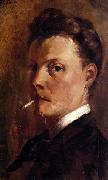 |
Henri-Edmond Cross
|
|
(May 20, 1856 - May 16, 1910) was a French pointillist painter.
Cross was born in Douai and grew up in Lille. He studied at the École des Beaux-Arts. His early works, portraits and still lifes, were in the dark colors of realism, but after meeting with Claude Monet in 1883, he painted in the brighter colors of Impressionism. In 1884, Cross co-founded the Societe des Artistes Independants with Georges Seurat. He went on to become one of the principal exponents of Neo-Impressionism. He began his Pointillist period after spending time with Paul Signac in 1904. His later works are Fauvist, perhaps influenced by his acquaintance with Henri Matisse.
His final years, plagued by rheumatism, were spent in Saint-Clair[disambiguation needed ], where he died in 1910. His pieces include The Church of Santa Maria degli Angely Near Assisi (1909) and Landscape with Stars.
The Allen Memorial Art Museum (Oberlin College, Ohio), the Block Museum of Art (Northwestern University, Illinois), The Art Institute of Chicago, the Fine Arts Museums of San Francisco, Harvard University Art Museums, the Hermitage Museum, the Honolulu Academy of Arts, Kröller-Meller Museum, the Los Angeles County Museum of Art, the Metropolitan Museum of Art, Museum of Grenoble (Grenoble, France), Musee d'Orsay (Paris), Musee Malraux (Le Havre, France), Musee Richard Anacreon (Granville, France), the Museum of Modern Art (New York City), the National Gallery of Art (Washington D.C.), New Art Gallery (Walsall, England), the Tel Aviv Museum of Art and the Thyssen-Bornemisza Museum (Madrid), are among the public collections holding works by Henri-Edmond Cross.
|
|
|
|
|
|
|
|
|
|
|
|
 |
Jacob Heinrich Elbfas
|
|
Swedish, born circa 1600-1664,was a portrait painter Elbfas was educated in Strasbourg in a tradition drawing back to Renaissance portraits. He established himself in Sweden from 1622 and from 1628 in Stockholm where he became a guild master. During the period 1634-1640 he worked as a court painter for Queen Maria Eleonora. His was frequently employed by the Swedish nobility and his influence on Swedish art was considerable until a new generation of artists were invited by Queen Christina during the 1640s. |
|
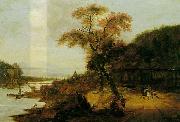 |
Jacob van der Does
|
|
(4 March 1623, Amsterdam - buried 17 November 1673, Sloten) was a Dutch Golden Age landscape painter.
Van der Does was the son of the secretary of the Amsterdam city council. He was more attracted to the arts than to note-taking, and went to study drawing with Claes Corneliszoon Moeyaert. He left at 21 to go to France, and from there on foot to Italy. In Rome he joined the Bentvueghels and was dubbed Tamboer, which means drummerboy, since he was somewhat short and had been meant for the military life. He studied with Pieter van Laer (Bamboots). When he eventually returned North, he settled in The Hague where he married Margaretha Boortens and got 4 sons and a daughter. His wife died in 1661. Houbraken liked his natural style of painting, and especially his way of painting sheep was very admirable.His wife's sister was Maria Boortens, and they both were good artists themselves. All three of them made drawings for the album of the wealthy Hague diplomat Cornelis de Glarges in 1659. Through Maria Boortens, Jacob van der Does was connected to Jacob van Campen and Adriaen van Nieulandt the younger. He became involved in the Guild of St. Luke in The Hague. He was one of the founders of the Confrerie Pictura in 1656. His pupils were Theodor Bernoille, Marcus de Bye, Gamaliel Day, Alexander Havelaer, Anthony Schinckels, and his sons Jacob II and Simon van der Does. |
|
 |
Jacopo da Empoli
|
|
1554-1640
Italian
Jacopo da Empoli Location
Italian painter and draughtsman. He lived and worked in Florence all his life, and he followed Santi di Tito in the return to the clarity of the Florentine High Renaissance. He absorbed the ideas of his more innovative contemporaries and became one of the most popular painters of altarpieces for churches in Florence and Tuscany. He was also a distinguished still-life painter and received many commissions from private patrons, among them the Medici. Empoli painting is distinguished by simple, lucid forms, strong colour and direct and clear interpretation of the subject. |
|
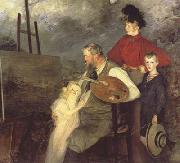 |
Jacques-Emile Blanche
|
|
(1 January 1861 - 20 September 1942) was a French painter born in Paris. His father was a successful psychiatrist who ran a fashionable clinic, and Blanche was brought up in the rich Parisian neighborhood of Passy in a house that had belonged to the Princesse de Lamballe. Although he received some instruction in painting from Henri Gervex, he may be regarded as self-taught. He became a very successful portrait painter, with a style derived from 18th-century English painters such as Thomas Gainsborough as well as Edouard Manet and John Singer Sargent. He worked in London, where he spent time from 1870 on, as well as Paris, where he exhibited at the Salon and the Sociate Nationale des Beaux-Arts. One of his closest friends was Marcel Proust, who helped edit several of Blanche's publications. He also knew Henry James and is mentioned in Gertrude Stein's The Autobiography of Alice B. Toklas. Among the painter's most famous works are portraits of his father, Marcel Proust (Private collection, Paris), the poet Pierre Louÿs, the Thaulow family (Musee d'Orsay, Paris), Aubrey Beardsley (National Portrait Gallery, London), and Yvette Guilbert.
He was the author of the unreliable Portraits of a Lifetime: the late Victorian era: the Edwardian pageant: 1870-1914 (London: J.M. Dent, 1937) and More Portraits of a Lifetime, 1918-1938 (London: J.M. Dent, 1939). |
|
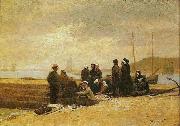 |
Jacques-Eugene Feyen
|
|
(1815, in Bey-sur-Seille, Meurthe-et-Moselle - 1908) was a French painter.
The elder brother of painter Auguste Feyen-Perrin, Jacques-Eugene enrolled at the Ecole des Beaux-Arts and studied under Paul Delaroche. He had a notable career at the Paris Salon from 1841 to 1882. Vincent Van Gogh was a fan of Feyen and describes him as, "one of the few painters who pictures intimate modern life as it really is, and does not turn it into fashion plates." He set up studio and settled in summer in the town of Cancale.He spent several months every year painting views of Cancale, the oyster-picking Cancalaises and the bay of Mont St. Michel, and his paintings still enjoy a steady fame.
|
|
|
|
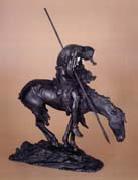 |
James Earle Fraser
|
|
American Sculptor, 1876-1953,American sculptor, b. Winona, Minn., studied at the Art Institute of Chicago and in Paris. The best known of his many works are The End of the Trail (Visalia, Calif.), the designs for the Indian head nickel, and a statue of Alexander Hamilton |
|
|
|
 |
James Ensor
|
|
Belgian
1860-1949
Belgian painter, printmaker and draughtsman. No single label adequately describes the visionary work produced by Ensor between 1880 and 1900, his most productive period. His pictures from that time have both Symbolist and Realist aspects, and in spite of his dismissal of the Impressionists as superficial daubers he was profoundly concerned with the effects of light. His imagery and technical procedures anticipated the colouristic brilliance and violent impact of Fauvism and German Expressionism and the psychological fantasies of Surrealism. Ensor most memorable and influential work was almost exclusively produced before 1900, but he was largely unrecognized before the 1920s in his own country. His work was highly influential in Germany, however: Emil Nolde visited him in 1911, and was influenced by his use of masks; Paul Klee mentions him admiringly in his diaries; Erich Heckel came to see him in the middle of the war and painted his portrait (1930; Cologne, Wallraf-Richartz-Mus.); Alfred Kubin owned several of his prints, while Marc Chagall and George Grosz also adapted certain elements from Ensor. All the artists of the Cobra group saw him as a master. He influenced many Belgian artists including Leon Spilliaert, Rik Wouters, Constant Permeke, Frits van den Berghe, Paul Delvaux and Pierre Alechinsky. |
|
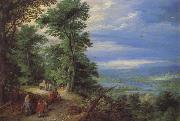 |
Jan Brueghel The Elder
|
|
Flemish Baroque Era Painter, 1568-1625
was a Flemish painter, son of Pieter Brueghel the Elder and father of Jan Brueghel the Younger. Nicknamed "Velvet" Brueghel, "Flower" Brueghel, and "Paradise" Brueghel, of which the latter two were derived from favored subjects, while the former may refer to the velveteen sheen of his colors or to his habit of wearing velvet. He was born in Brussels. His father died in 1569, and then, following the death of his mother in 1578, Jan, along with his brother Pieter Brueghel the Younger ("Hell Brueghel") and sister Marie, went to live with their grandmother Mayken Verhulst (widow of Pieter Coecke van Aelst). She was an artist in her own right, and according to Carel van Mander, possibly the first teacher of the two sons. The family moved to Antwerp sometime after 1578. He first applied himself to painting flowers and fruits, and afterwards acquired considerable reputation by his landscapes and sea-pieces. He formed a style more independent of his father's than did his brother Pieter the Younger. His early works are often landscapes containing scenes from scripture, particularly forest landscapes betraying the influence of the master forest landscape-painter Gillis van Coninxloo. Later in his career, he moved toward the painting of pure landscapes and townscapes, and, toward the end, of still lifes. After residing long at Cologne he travelled into Italy, where his landscapes, adorned with small figures, were greatly admired. He left a large number of pictures, chiefly landscapes, which are executed with great skill. Many of his paintings are collaborations in which figures by other painters were placed in landscapes painted by Jan Brueghel. |
|
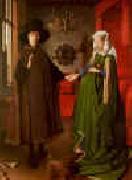 |
Jan Van Eyck
|
|
1395-1441
Flemish
Jan Van Eyck Locations
Painter and illuminator, brother of Hubert van Eyck.
According to a 16th-century Ghent tradition, represented by van Vaernewijck and Lucas d Heere, Jan trained with his brother Hubert. Pietro Summonte assertion (1524) that he began work as an illuminator is supported by the fine technique and small scale of most of Jan works, by manuscript precedents for certain of his motifs, and by his payment in 1439 for initials in a book (untraced) for Philip the Good, Duke of Burgundy. Jan is first documented in The Hague in August 1422 as an established artist with an assistant and the title of Master, working for John III, Count of Holland (John of Bavaria; reg 1419-25), who evidently discovered the artist while he was bishop (1389-1417) of the principality of Liege. Jan became the court official painter and was paid, with a second assistant when the work increased in 1423, continuously, probably until the count death in January 1425. |
|
|
|
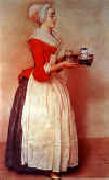 |
Jean-Etienne Liotard
|
|
1702-1789
Swiss
Jean Etienne Liotard Gallery
He began his studies under Professor Gardelle and Petitot, whose enamels and miniatures he copied with considerable skill. He went to Paris in 1725, studying under J. B. Masse and François Lemoyne, on whose recommendation he was taken to Naples by the Marquis Puysieux. In 1735 he was in Rome, painting the portraits of Pope Clement XII and several cardinals. Three years later he accompanied Lord Duncannon to Constantinople. His eccentric adoption of oriental costume secured him the nickname of the Turkish painter. He went to Vienna in 1742 to paint the portraits of the imperial family. Still under distinguished patronage he returned to Paris. In 1744 he visited England, where he painted the princess of Wales in 1753, and went to Holland in 1756, where, in the following year, he married Marie Fargues. She also came from a Hugenot family, and wanted him to shave off his beard. Another visit to England followed in 1772, and in the next two years his name figures among the Royal Academy exhibitors. He returned to his native town in 1776. In 1781 Liotard published his Trait?? des principes et des r??gles de la peinture. In his last days he painted still lifes and landscapes. He died at Geneva in 1789.
Liotard was an artist of great versatility, and though his fame depends largely on his graceful and delicate pastel drawings, of which La Liseuse, The Chocolate Girl, and La Belle Lyonnaise at the Dresden Gallery are delightful examples, he achieved distinction by his enamels, copperplate engravings and glass painting. He also wrote a Treatise on the Art of Painting, and was an expert collector of paintings by the old masters. Many of the masterpieces he had acquired were sold by him at high prices on his second visit to England. The museums of Amsterdam, Berne, and Geneva are particularly rich in examples of his paintings and pastel drawings. A picture of a Turk seated is at the Victoria and Albert Museum, while the British Museum owns two of his drawings. The Louvre has, besides twenty-two drawings, a portrait of Lieutenant General Hrault and a portrait of the artist is to be found at the Sala di pittori, in the Uffizi Gallery, Florence. While his son also married a Dutch girl, the Rijksmuseum inherited an important collection of his drawings and paintings. |
|
 |
Jean-Louis-Ernest Meissonier
|
|
French Academic Painter, 1815-1891,French painter, sculptor and illustrator. Although he was briefly a student of Jules Potier (1796-1865) and Leon Cogniet, Meissonier was mainly self-taught and gained experience by designing wood-engravings for book illustrations. These included Leon Curmer's celebrated edition of J.-H. Bernardin de Saint-Pierre's Paul et Virginie (Paris, 1838), the series Les Franeais peints par eux-memes (Paris, 1840-42) and Louis de Chevigne's Les Contes remois (Paris, 1858). |
|
 |
Jeles-Eugene Lenepveu
|
|
French Neoclassical Painter, 1819-1898.
Studied under François-Edward Picot. |
|
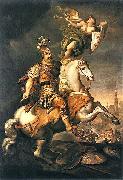 |
Jerzy Siemiginowski-Eleuter
|
|
(ca. 1660 - ca. 1711) was a prominent Polish painter and engraver of the Baroque, court painter of king John III Sobieski and a Polish-Lithuanian noble. He is considered one of the most accomplished painters of Classical Baroque in Poland, who joined in his works classical theory with genuine motives.
|
|
|
|
|
|
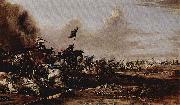 |
Johann Anton Eismann
|
|
(1604-1698) was an Austrian painter.
Eismann was born in Salzburg, and was active in Verona and Venice. He painted primarily harbor and some battle genre scenes. He died in Venice in 1698. |
|
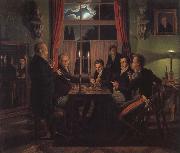 |
Johann Erdmann Hummel
|
|
1769 Kassel-1852 Berlin,German painter and writer. He studied from 1782 in the architecture class at the Akademie der Bildenden K?nste at Kassel and subsequently under the Kassel court painter, Wilhelm B?ttner. Hummel retained his connection with architecture, however, and this is manifested in his overpowering concern with structure and perspective. The Kassel court granted Hummel funds for travel and study in Italy and, in 1792, he went to Rome, where he joined a group of fellow Germans, including the painters Johann Christian Reinhart, Johann Martin von Rohden, Friedrich Bury and the architect Friedrich Weinbrenner. In 1796 Joseph Anton Koch joined the group. Hummel also attended the philosophical lectures given by Carl Ludwig Fernow (1763-1808) and became a friend of the archaeologist Aloys Hirt. In Rome, |
|
|
|
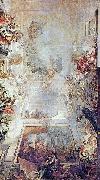 |
Johann Evangelist
|
|
Johann Evangelist Holzer (December 24, 1709 - July 21, 1740) was an Austrian-German painter.
Holzer was born in Burgeis, Mals, in the Vinschgau Valley of South Tyrol, as the son of a miller. He was sent to undertake a classical course of study at Marienberg Abbey, but wished to study art; a portrait he painted of Johann Baptist Murr, then the abbot of the abbey, convinced his father to yield to his wishes. He studied under Nikolaus Auer and made rapid progress. At the age of 18 he painted the altarpiece of the Marienberg Abbey church, depicting Saint Joseph as patron of the afflicted, ill, and dying. He then went to Straubing, where he learned under Joseph Anton Merz how to paint frescos, which would become the main source of his later fame. He helped Merz paint the frescos of Oberalteich Abbey, and while in Straubing also painted Saint Anthony of Padua for the Franciscan church there.
1738/39 was in the painting of Eichstätt for the high altar of the Schutzengelkirche It is Holzer's largest painting on canvas (H: 8,36 m; B: 4,28 m) and impresses through movement, gesture, a dynamic composition, and a sophisticated lighting design. Although there are two pictures (side altars) signatures of Bergmeller, they will Holzer, assigned by the archives occupied painter of the high altar painting. |
|
|
|
|
|
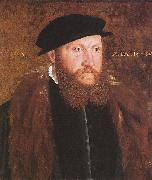 |
John Bettes the Elder
|
|
(active c. 1531 - 1570) was a Tudor artist whose few known paintings date from between about 1543 and 1550. His most famous work is his Portrait of a Man in a Black Cap. His son John Bettes the Younger, with whom he is sometimes confused, was a pupil of Nicholas Hilliard who painted portraits during the reign of Elizabeth I and James I.
Nothing is known of John Bettes's life, except that he was living in Westminster in 1556, according to a documented court case. He is first recorded as working for Henry VIII at Whitehall Palace in 1531. Queen Catherine Parr's accounts for 1546/47 record payments to Bettes for "lymning" (painting in miniature) the king's and queen's portraits, and for six other portraits. Her new year's gift of 1547 to Prince Edward was a pair of portraits of the king and herself. Bettes has been identified as the designer of the engraved title-border for William Cuningham's Cosmographical Glasse, printed by John Day in 1559. He may also be the designer of engravings for Edward Hall's Chronicle, published in 1550, and of a woodcut portrait of Franz Burchard, the Saxon ambassador to England, published in 1560. In 1576, John Foxe referred to Bettes as already dead. An earlier second edition of Foxe's Actes and Monuments printed in 1570 refers to Bettes' death. |
|
|
|
|
|
|
|
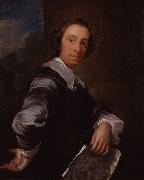 |
John Giles Eccardt
|
|
John Giles Eccardt (1720 - 1779) was a German-born British portrait painter. He came to England in the company of the French painter Jean-Baptiste van Loo for whom he worked as an assistant. When Van Loo departed the country, Eccardt remained and set up a portrait-painting business. In the following years he did portraits of a number of leading members of British society including twenty six of his chief patron Horace Walpole. He died in 1779. |
|
|
|
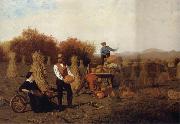 |
John Whetten Ehninger
|
|
American Painter, 1827-1889,American painter and illustrator. After graduating from Columbia College, New York, in 1847, he immediately departed for Europe to pursue artistic training. He visited Italy and France, but staying in Germany, specifically D?sseldorf, was his main objective. There he studied with Karl Friedrich Lessing, Carl Ferdinand Sohn and fellow American Emanuel Leutze, and in Paris he was instructed by Thomas Couture. During the early 1850s he travelled between America and Europe but finally settled in New York in 1853 until his move to Saratoga Springs after marrying in 1877. Ehninger exhibited regularly at the National Academy of Design, New York, where he was elected a full member in 1860. |
|
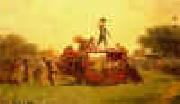 |
Jonathan Eastman Johnson
|
|
1824-1906
Jonathan Eastman Johnson Galleries
Eastman Johnson (July 29, 1824 - April 5, 1906) was an American painter, and Co-Founder of the Metropolitan Museum of Art, New York City, with his name inscribed at its entrance. Best known for his genre paintings, paintings of scenes from everyday life, and his portraits both of everyday people, he also painted portraits of prominent Americans such as Abraham Lincoln, Nathaniel Hawthorne, Ralph Waldo Emerson, and Henry Wadsworth Longfellow. His later works often show the influence of the 17th century Dutch masters whom he studied while living in The Hague, and he was even known as The American Rembrandt in his day.
Johnson's style is largely realistic in both subject matter and in execution. His original photorealistic charcoal sketches were not strongly influenced by period artists, but are informed more by his lithography training. Later works show influence by the 17th century Dutch and Flemish masters, and also by Jean François Millet. Echoes of Millet's The Gleaners can be seen in Johnson's The Cranberry Harvest, Island of Nantucket although the emotional tone of the work is far different.
His careful portrayal of individuals rather than stereotypes enhances the realism of his paintings. Ojibwe artist Carl Gawboy notes that the faces in the 1857 portraits of Ojibwe people by Johnson are recognizable in people in the Ojibwe community today. Some of his paintings such as Ojibwe Wigwam at Grand Portage display near photorealism long before the photorealism movement but in keeping with the American tradition of realism that can be seen in the works of Charles Willson Peale whose painting The Stairway Group is said to have fooled George Washington.
His careful attention to light sources contributes to the realism. Portraits Girl and Pets and The Boy Lincoln make use of single light sources in a manner that echoes the 17th Century Dutch Masters. |
|
|
|
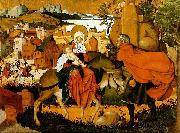 |
Jorg Breu the Elder
|
|
(c. 1475 -- 1537), of Augsburg, was a painter of the German Danube school. He was the son of a weaver.
He journeyed to Austria and created several multi-panel altarpieces there in 1500-02, such as the Melk Altar (1502). He returned to Augsburg in 1502 where he became a master. He travelled to Italy twice, in ca. 1508 and in 1514/15.
After his death in 1537, his son, Jörg Breu the Younger continued to lead his Augsburg workshop until his own death 10 years later. |
|
|
|
|
|
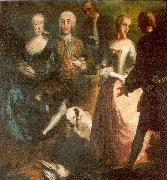 |
Joseph Esperlin
|
|
painted Engagement of Maria Josepha Grafin von Waldburg-Friedberg-Scheer (1731 - 1782) and her cousin, Prince Joseph Wenzel von Furstenberg (1728 - 1783) in 1748 |
|
 |
Joseph Heintz the Elder
|
|
the Elder (Basle, 11 June 1564 - near Prague, Bohemia, October 1609) was a Swiss painter, draftsman and architect.
He appears to have been a pupil of Hans Bock, and to have educated himself by diligent practice in copying the works of Hans Holbein the younger. Between 1585 and 1587 he lived in Rome, registering himself a pupil; to Hans von Aachen. He next settled in Bohemia in 1591, and was at once appointed court painter to Rudolf II, but he remained in Prague for two years only, as in 1593 he was commissioned to make some copies from the antique for the emperor, and for that purpose went to Rome, where he spent some years. In 1604 we hear of him in Augsburg, and from the time we know little of his history, until his decease is recorded in a village outside of Prague.
Heintz's paintings included religious images, portraits, and, following the emperor's taste, erotic mythological themes. They were at one time in high demand, but later on suffered an eclipse. Among them are a family portrait in Berne and that of Rudolf II in Vienna. He was constantly investigating subtle questions of light, and almost all of his landscapes show the interest he took in this technical matter. A notable work by him is the Rape of Proserpine, which hangs in the Dresden Gallery, and was engraved by Lukas Kilian; in the same gallery are two other works, Lot and His Daughters and Ecce Homo. Finally there is his portrait of Constance of Austria. He had a son, who bore the same name, and who painted a few religious pictures; several of these works hitherto attributed to the son are now believed to be late productions by the father.
|
|
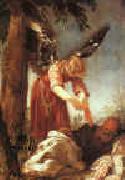 |
Juan Antonio Escalante
|
|
Spanish Baroque Era Painter, 1633-1670
Spanish painter. He was an outstanding figure in decorative Baroque art. When quite young he moved from Andalusia to Madrid, where he apparently worked with and was influenced by Francisco Rizi. His artistic development reveals an increasing admiration for Veronese, Tintoretto and Titian, although elements of the style of Alonso Cano persist. Among his first works is Andromeda and the Dragon (c. 1659; Madrid, Prado), whose mannerist elements derive from an engraving of the subject by Agostino Carracci. The two brilliant works St Catherine of Alexandria (Madrid, Las Maravillas) and Road to Calvary (Madrid, Real Acad. S Fernando), signed and dated 1660, are executed with an agile and self-assured technique, in colours that stem from Venetian painting. Like other Spanish painters of the period, he painted numerous versions of the Immaculate Conception (e.g. 1660, Colegio de Villafranca de los Barros; 1663, Budapest, Mus. F.A.; c. 1666, Benedictine monastery of Lumbier, Navarre), which are more Baroque in style and expression than those of Jose Antolenez and Mateo Cerezo. In these the faces, surrounded by luxuriant hair, is expressed an innocent candour that contrasts with the turbulent appearance of the cherubs. Also characteristic of his style are the versions of the Annunciation (1653; New York, Hisp. Soc. America Mus; B?ziers, Mus. B.-A.). He treated the theme of St Joseph with great nobility, as in the Dream of St Joseph (1666; New York, Chrysler Col.). His deep lyrical feelings pervade the various paintings of the Infant St John (Madrid, Prado). |
|
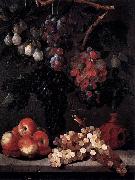 |
Juan Bautista de Espinosa
|
|
(1590-1641, Madrid) was a Spanish still life painter.
More paintings remain of him than biographical data and there is only one known painting remaining.
It is only known that he worked in Toledo and Madrid from 1612 to 1626 and, judging by his style, he was trained in Holland. De Espinosa's style is judged to be the transition from Flemish Baroque to Spanish Baroque.
Several mural paintings in Spanish churches are also attributed to him; one of these is in Alcaudete.
|
|
 |
Juan de Espinosa
|
|
Spanish Baroque Era Painter, ca.1590-1641
Spanish painter. Details of his life are scarce. He is documented in Madrid and Toledo between 1612 and 1626, and while he is recorded as having painted religious pictures and portraits (untraced), he is only known today for his still-life paintings. Documents relating to another artist of the same name, known as Juan de Espinosa, dating from 1645 to 1677, concern a different painter. |
|
 |
Juan de Espinosa
|
|
Spanish Baroque Era Painter, ca.1590-1641, Spanish painter. Details of his life are scarce. He is documented in Madrid and Toledo between 1612 and 1626, and while he is recorded as having painted religious pictures and portraits (untraced), he is only known today for his still-life paintings. Documents relating to another artist of the same name, known as Juan de Espinosa, dating from 1645 to 1677, concern a different painter. |
|
|

